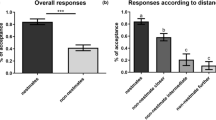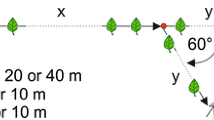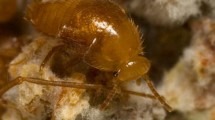Abstract
Nestmate recognition was studied in the Southeast Asian stingless beeTrigona (Tetragonula) minangkabau, a species in which worker oviposition has not been observed in queenright or queenless colonies. When conspecific non-nestmate foragers from queenright and queenless colonies were introduced to the observed colony, they were all rejected by guards. Foragers of a different species (Trigona (Tetragonisca) angustula) were also completely rejected. However, conspecific non-nestmate callows were accepted as often as were nestmate callows, although guards recognized the difference. Accepted non-nestmate callows exchanged food with guards equally as much as nestmate callows did.
Similar content being viewed by others
References
Breed, M.D. 1983 Nestmate recognitio in honey bees.Anim. Behav. 31: 86–91.
Breed, M.D. & B. Bennett 1987 Kin recognition in highly eusocial insects. In: D.J.C. Fletcher & C.D. Michener (eds.)Kin Recognition in Animals. pp. 243–285. John Wiley & Sons, New York.
Breed, M.D. & R.E. Page, Jr. 1991 Intra- and interspecific nestmate recognition inMelipona workers (Hymenoptera: Apidae).J. Insect Behav. 4: 463–469.
Buckle, G.R. & L. Greenberg 1981 Nestmate recognition in sweat bees (Lasioglossum zephyrum): Does an individual recognize its own odour or only odours of its nestmates?Anim. Behav. 29: 802–809.
Carlin, N.F. & P.C. Frumhoff 1990 Nepotism in the honey bee.Nature 346: 706–708.
Crozier, R.H. 1987 Genetic aspects of kin recognition: concepts, models, and synthesis. In: D.J.C. Fletcher & C.D. Michener (eds.)Kin Recognition in Animals. pp. 55–73. John Wiley & Sons, New York.
Engels, W. & V.L. Imperatriz-Fonseca 1990 Caste development, reproductive strategies, and control of fertility in honey bees and Stingless bees In: W. Engels (ed.)Social Insects. pp. 167–230. Springer-Verlag, Berlin.
Grafen, A. 1990 Do animals really recognize kin? Anim.Behav. 39: 42–54.
Grafen, A. 1991 Kin vision?: a reply to Stuart.Anim. Behav. 41: 1095–1096.
Greenberg, L. 1979 Genetic component of bee odor in kin recognition.Science 206: 1095–1097.
Inoue, T. & D.W. Roubik 1990 Kin recgnition of stingless bee,Melipona fasciata. In: G.K. Veeresh, B. Mallik & C.A. Viraktamath (eds.)Social Insects and the Environment. pp. 517–518. Oxford & IBH, New Delhi.
Inoue, T. 1993 Kin recognition in social insects. In: T. Inoue & S. Yamane (eds.)Evolution of Insect Societies. pp. 147–206. Hakuhin-sha, Tokyo.
Michener, C.D. 1974The social behavior of the bees: A comparative study. Belknap Press of Harvard University Press, Cambridge Mass.
Michener, C.D. & B.H. Smith 1987 Kin recognition in primitively eusocial insects. In: D.J.C. Fletcher & C.D. Michener (eds.)Kin Recognition in Animals. pp. 209–242. John Wiley & Sons, New York.
Moritz, R.F.A. & E. Hilesheim 1990 Trophallaxis and genetic variance of kin recognition in honey bees,Apis mellifera L.Anim. Behav. 40: 641–647.
Page, R.E., M.D. Breed & W.M. Getz 1990 Nepotism in the honey bee.Nature 346: 706–708.
Page, R.E., Jr., G.E. Robinson & M.K. Fondrk 1989 Genetic specialists, kin recognition and nepotism in honey-bee colonies.Nature 338: 576–579.
Roubik, D.W. 1990 Mate location and mate competition in males of stingless bees (Hymenoptera: Apidae: Meliponinae).Entomol. Gener. 15: 115–120.
Sakagami, S.F. 1982 Stingless bees, In: Hermann (ed.)Social Insects. III 4: pp. 361–423. Academic Press, New York.
Sakagami, S.F. & T. Inoue 1985 Taxonomic notes on three bicolorousTetragonula stingless bees in Southeast Asia.Kontyû 53: 174–189.
Sakagami, S.F., T. Inoue, S. Yamane & S. Salmah 1983a Nest architecture and colony composition of the Sumatran stingless beeTrigona (Tetragonula) laeviceps.Kontyû 51: 100–111.
Sakagami, S.F., S. Yamane & T. Inoue 1983b Oviposition behavior of two Southeast Asian stingless bees,Trigona (Tetragonula) laeviceps andT. (T.) pagdeni.Kontyû 51: 441–457.
Salmah, S., T. Inoue & S.F. Sakagami 1984 Relationship between age sequence and pigmentation in the stingless beeTrigona (Tetragonula) laeviceps.J. Apic. Res. 23: 55–58.
Salmah, S. 1987 Postembryonic development and division of labor in three species of Sumatran stingless bees. Ph. D. thesis, Hokkaido University, Japan.
Stuart, R.J. 1991 Kin recognition as a functional concept.Anim. Behav. 41: 1093–1094.
Tezuka, T., Y. Maeta & T. Inoue 1990 Duration of life and division of labor of the Sumatran stingless beeTrigona minangkabau. In: {btThe Abstracts of 9th Annual Meeting of Japan Ethological Society}. pp. 38.
Visscher, P.K. 1986 Kinship discrimination in queen rearing by honey bees (Apis mellifera).Behav. Ecol. Sociobiol. 18: 453–460.
Visscher, P.K. 1989 A quantitative study of worker reproduction in honey bee colonies.Behav. Ecol. Sociobiol. 25: 247–254.
Wittmann, D., L.R. Bego, R. Zucchi & S.F. Sakagami 1991 Oviposition behavior and related aspects of the stingless bees. XIV.Plebeia (Mourella) caerulea, with comparative notes on the evolution of the oviposition patterns (apidac, Meliponinae).Jpn. J. Ent. 59: 793–809.
Author information
Authors and Affiliations
About this article
Cite this article
Suka, T., Inoue, T. Nestmate recognition of the stingless beeTrigona (Tetragonula) minangkabau (Apidae: Meliponinae). J. Ethol. 11, 141–147 (1993). https://doi.org/10.1007/BF02350047
Received:
Accepted:
Issue Date:
DOI: https://doi.org/10.1007/BF02350047




